Papers by Giovanni Anobile
Journal of Experimental Child Psychology, 2013
In this study, we investigated in school-age children the relationship among mathematical perform... more In this study, we investigated in school-age children the relationship among mathematical performance, the perception of numerosity (discrimination and mapping to number line), and sustained visual attention. The results (on 68 children between 8 and 11 years of age) show that attention and numerosity perception predict math scores but not reading performance. Even after controlling for several variables, including age, gender, nonverbal IQ, and reading accuracy, attention remained correlated with math skills and numerosity discrimination. These findings support previous reports showing the interrelationship between visual attention and both numerosity perception and math performance. It also suggests that attentional deficits may be implicated in disturbances such as developmental dyscalculia.
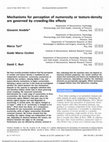
Journal of Vision, 2015
We have recently provided evidence that the perception of number and texture density is mediated ... more We have recently provided evidence that the perception of number and texture density is mediated by two independent mechanisms: numerosity mechanisms at relatively low numbers, obeying Weber's law, and texture-density mechanisms at higher numerosities, following a square root law. In this study we investigated whether the switch between the two mechanisms depends on the capacity to segregate individual dots, and therefore follows similar laws to those governing visual crowding. We measured numerosity discrimination for a wide range of numerosities at three eccentricities. We found that the point where the numerosity regime (Weber's law) gave way to the density regime (square root law) depended on eccentricity. In central vision, the regime changed at 2.3 dots/8 2 , while at 158 eccentricity, it changed at 0.5 dots/8 2 , three times less dense. As a consequence, thresholds for low numerosities increased with eccentricity, while at higher numerosities thresholds remained constant. We further showed that like crowding, the regime change was independent of dot size, depending on distance between dot centers, not distance between dot edges or ink coverage. Performance was not affected by stimulus contrast or blur, indicating that the transition does not depend on low-level stimulus properties. Our results reinforce the notion that numerosity and texture are mediated by two distinct processes, depending on whether the individual elements are perceptually segregable. Which mechanism is engaged follows laws that determine crowding.
Vision Research, 2012
Various aspects of numerosity judgments, especially subitizing and the mapping of number onto spa... more Various aspects of numerosity judgments, especially subitizing and the mapping of number onto space, depend strongly on attentional resources. Here we use a dual-task paradigm to investigate the effects of cross-sensory attentional demands on visual subitizing and spatial mapping. The results show that subitizing is strongly dependent on attentional resources, far more so than is estimation of higher numerosities. But unlike many other sensory tasks, visual subitizing is equally affected by concurrent attentionally demanding auditory and tactile tasks as it is by visual tasks, suggesting that subitizing may be amodal. Mapping number onto space was also strongly affected by attention, but only when the dual-task was in the visual modality. The non-linearities in numberline mapping under attentional load are well explained by a Bayesian model of central tendency.
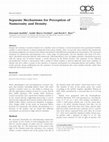
Psychological Science, 2014
Despite the existence of much evidence for a number sense in humans, several researchers have que... more Despite the existence of much evidence for a number sense in humans, several researchers have questioned whether number is sensed directly or derived indirectly from texture density. Here, we provide clear evidence that numerosity and density judgments are subserved by distinct mechanisms with different psychophysical characteristics. We measured sensitivity for numerosity discrimination over a wide range of numerosities: For low densities (less than 0.25 dots/ deg 2 ), thresholds increased directly with numerosity, following Weber's law; for higher densities, thresholds increased with the square root of texture density, a steady decrease in the Weber fraction. The existence of two different psychophysical systems is inconsistent with a model in which number is derived indirectly from noisy estimates of density and area; rather, it points to the existence of separate mechanisms for estimating density and number. These results provide strong confirmation for the existence of neural mechanisms that sense number directly, rather than indirectly from texture density.
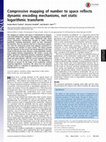
Proceedings of the National Academy of Sciences, 2014
The mapping of number onto space is fundamental to measurement and mathematics. However, the mapp... more The mapping of number onto space is fundamental to measurement and mathematics. However, the mapping of young children, unschooled adults, and adults under attentional load shows strong compressive nonlinearities, thought to reflect intrinsic logarithmic encoding mechanisms, which are later "linearized" by education. Here we advance and test an alternative explanation: that the nonlinearity results from adaptive mechanisms incorporating the statistics of recent stimuli. This theory predicts that the response to the current trial should depend on the magnitude of the previous trial, whereas a static logarithmic nonlinearity predicts trialwise independence. We found a strong and highly significant relationship between numberline mapping of the current trial and the magnitude of the previous trial, in both adults and school children, with the current response influenced by up to 15% of the previous trial value. The dependency is sufficient to account for the shape of the numberline, without requiring logarithmic transform. We show that this dynamic strategy results in a reduction of reproduction error, and hence improvement in accuracy.
Journal of Experimental Child Psychology, 2013
In this study, we investigated in school-age children the relationship among mathematical perform... more In this study, we investigated in school-age children the relationship among mathematical performance, the perception of numerosity (discrimination and mapping to number line), and sustained visual attention. The results (on 68 children between 8 and 11 years of age) show that attention and numerosity perception predict math scores but not reading performance. Even after controlling for several variables, including age, gender, nonverbal IQ, and reading accuracy, attention remained correlated with math skills and numerosity discrimination. These findings support previous reports showing the interrelationship between visual attention and both numerosity perception and math performance. It also suggests that attentional deficits may be implicated in disturbances such as developmental dyscalculia.
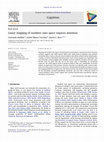
Cognition, 2012
Mapping of number onto space is fundamental to mathematics and measurement. Previous research sug... more Mapping of number onto space is fundamental to mathematics and measurement. Previous research suggests that while typical adults with mathematical schooling map numbers veridically onto a linear scale, pre-school children and adults without formal mathematics training, as well as individuals with dyscalculia, show strong compressive, logarithmic-like non-linearities when mapping both symbolic and non-symbolic numbers onto the numberline. Here we show that the use of the linear scale is dependent on attentional resources. We asked typical adults to position clouds of dots on a numberline of various lengths. In agreement with previous research, they did so veridically under normal conditions, but when asked to perform a concurrent attentionally-demanding conjunction task, the mapping followed a compressive, non-linear function. We model the non-linearity both by the commonly assumed logarithmic transform, and also with a Bayesian model of central tendency. These results suggest that veridical representation numerosity requires attentional mechanisms.
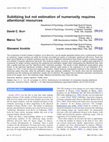
The numerosity of small numbers of objects, up to about four, can be rapidly appraised without er... more The numerosity of small numbers of objects, up to about four, can be rapidly appraised without error, a phenomenon known as subitizing. Larger numbers can either be counted, accurately but slowly, or estimated, rapidly but with errors. There has been some debate as to whether subitizing uses the same or different mechanisms than those of higher numerical ranges and whether it requires attentional resources. We measure subjects' accuracy and precision in making rapid judgments of numerosity for target numbers spanning the subitizing and estimation ranges while manipulating the attentional load, both with a spatial dual task and the "attentional blink" dual-task paradigm. The results of both attentional manipulations were similar. In the high-load attentional condition, Weber fractions were similar in the subitizing (2-4) and estimation (5-7) ranges (10-15%). In the low-load and single-task condition, Weber fractions substantially improved in the subitizing range, becoming nearly error-free, while the estimation range was relatively unaffected. The results show that the mechanisms operating over the subitizing and estimation ranges are not identical. We suggest that pre-attentive estimation mechanisms works at all ranges, but in the subitizing range, attentive mechanisms also come into play.
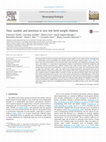
Neuropsychologia, 2015
Premature birth has been associated with damage in many regions of the cerebral cortex, although ... more Premature birth has been associated with damage in many regions of the cerebral cortex, although there is a particularly strong susceptibility for damage within the parieto-occipital lobes (Volpe, 2009). As these areas have been shown to be critical for both visual attention and magnitudes perception (time, space, and number), it is important to investigate the impact of prematurity on both the magnitude and attentional systems, particularly for children without overt white matter injuries, where the lack of obvious injury may cause their difficulties to remain unnoticed. In this study, we investigated the ability to judge time intervals (visual, audio and audio-visual temporal bisection), discriminate between numerical quantities (numerosity comparison), map numbers onto space (numberline task) and to maintain visuo-spatial attention (multiple-object-tracking) in school-age preterm children (N29). The results show that various parietal functions may be more or less robust to premat...




Uploads
Papers by Giovanni Anobile